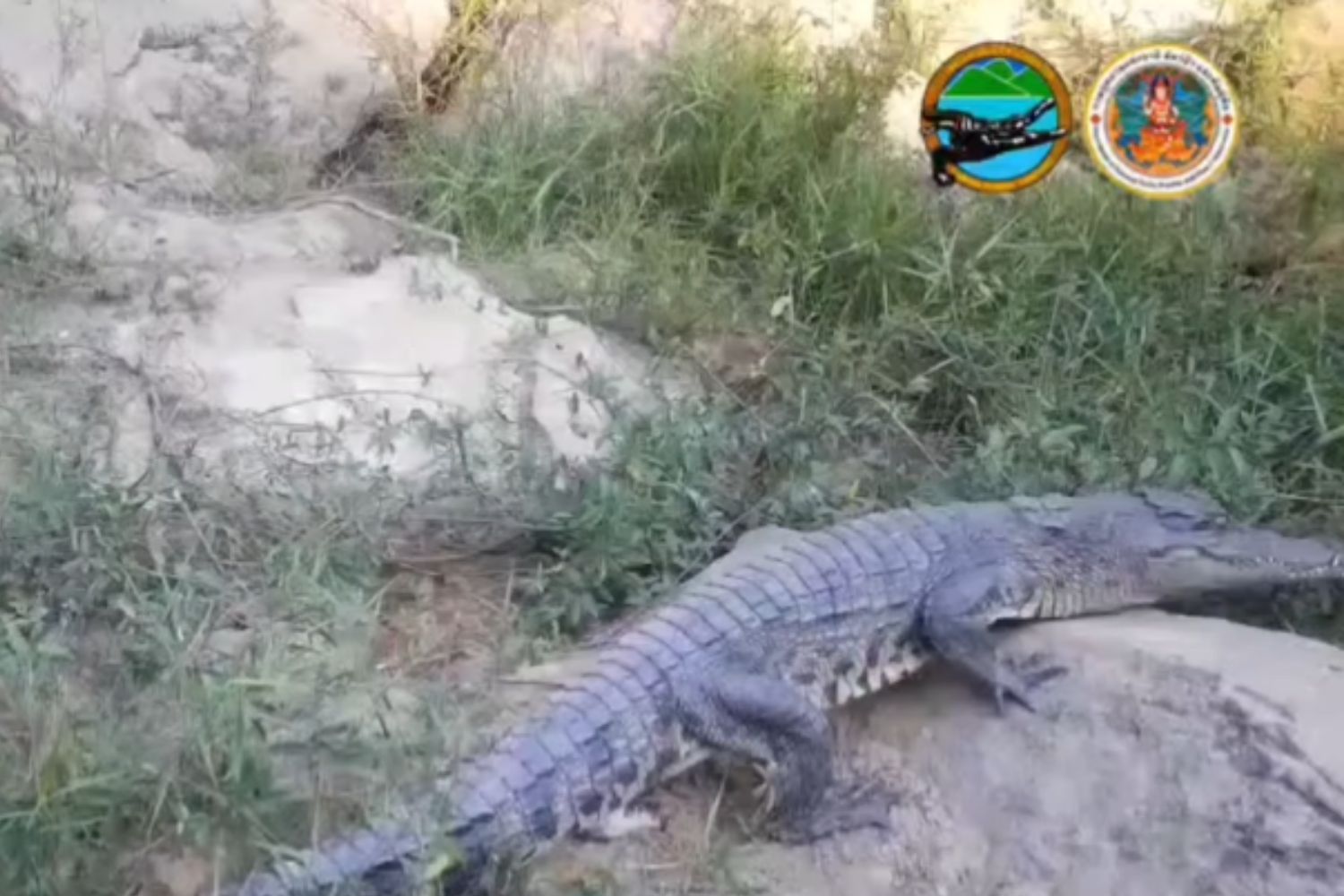It seemed like a creature relegated to the world of legends, a myth passed down from generation to generation. Yet, the Siamese crocodile has re-emerged from the mists of time, giving us an image of hope for the future of biodiversity

@Yod Dom Wildlife Sanctuary (FB)
Conservation groups have been engulfed by a tide of shock and disbelief at the recent discovery of a Siamese crocodile (Crocodylus siamensis) at Yod Dom Wildlife Sanctuary, Thailand. Once found widely throughout Southeast Asia’s freshwater habitats, the species has been virtually wiped out by habitat destruction and relentless hunting. It is now “critically endangered” on the IUCN Red List of Threatened Species.
The video, which went viral quickly over the internet, captures the crocodile basking in the sun on a rock along the Lam Dom Yai River, looking unbothered by the camera.
จระเข้น้ำจืดไทยในป่ายอดโดม!! สัญญาณแห่งความหวังของสายพันธุ์ใกล้สูญพันธุ์ความตื่นเต้นเกิดขึ้นในวงการอนุรักษ์สัตว์ป่าไทย เมื่อกล้องดักถ่ายภาพสัตว์ป่าในเขตรักษาพันธุ์สัตว์ป่ายอดโดมจับภาพได้สิ่งมีชีวิตที่แทบไม่น่าเชื่อว่าจะยังมีอยู่ในธรรมชาติ – จระเข้น้ำจืดสายพันธุ์ไทย (Crocodylus siamensis) สัตว์เลื้อยคลานที่ถูกจัดอยู่ในสถานะใกล้สูญพันธุ์อย่างยิ่งในธรรมชาติภาพถ่ายล่าสุดที่ได้ในช่วง 7-12 กุมภาพันธ์ 2568 แสดงให้เห็นจระเข้น้ำจืดหนึ่งตัวบนโขดหินริมแม่น้ำลำโดมใหญ่ นับเป็นการพบครั้งที่สองในรอบหนึ่งปี หลังจากที่มีการบันทึกภาพครั้งแรกเมื่อเดือนมีนาคม 2567 ที่ผ่านมาการพบจระเข้น้ำจืดในครั้งนี้ไม่ใช่เพียงการยืนยันการอยู่รอดของสายพันธุ์ แต่ยังแสดงให้เห็นถึงความอุดมสมบูรณ์ของระบบนิเวศในพื้นที่ การค้นพบครั้งสำคัญนี้ ทางในเขตรักษาพันธุ์สัตว์ป่ายอดโดมได้วางแผนดำเนินโครงการวิจัยนิเวศวิทยาและการกระจายตัวของจระเข้น้ำจืดในพื้นที่อย่างต่อเนื่อง พร้อมทั้งเดินหน้าสร้างความตระหนักรู้แก่ชุมชนท้องถิ่นถึงความสำคัญของการอนุรักษ์สัตว์ใกล้สูญพันธุ์ที่เคยแพร่หลายในแหล่งน้ำธรรมชาติทั่วประเทศไทย แต่ปัจจุบันเหลือให้พบเห็นน้อยมาก สะท้อนให้เห็นถึงความสำเร็จในการอนุรักษ์พื้นที่ป่าและแหล่งน้ำธรรมชาติของเขตรักษาพันธุ์สัตว์ป่ายอดโดม ที่ยังคงเป็นบ้านที่ปลอดภัยสำหรับสัตว์ป่าหายากหลากหลายชนิดเพื่อให้สัตว์ใกล้สูญพันธุ์เหล่านี้ยังคงมีที่อยู่อาศัยที่ปลอดภัยและสามารถสืบทอดสายพันธุ์ต่อไปได้ในอนาคต.#จระเจ้น้ำจืดไทย#เขตรักษาพันธุ์สัตว์ป่ายอดโดม#สำนักบริหารพื้นที่อนุรักษ์ที่9อุบลราชธานี
Posted by กรมอุทยานแห่งชาติ สัตว์ป่า และพันธุ์พืช on Sunday, February 16, 2025
This record sight is the second within less than two years. In March 2023, a Siamese crocodile was photographed using another camera trap, exciting specialists. Although they are not rare, these records suggest that small vestiges of the species might still be living in remote and well-protected nooks and crannies, which keeps it from being pushed towards extinction.
The Chalawan: a symbol of revival
The Siamese crocodile is not only a natural occurrence; it is also culturally entrenched in Thai society. “Chalawan” is the local name for the animal, and it is one of the central figures in ancient myths and legends, typically depicted as a magical being that can transform into a human being. Its reappearance after decades of absence has a meaning that transcends scientific discovery, symbolizing renewal and hope.
The Thai Department of National Parks has increased surveillance work in the area to study and conserve these last remaining individuals. Conservation of habitats is now top priority, and deforestation and pollution are dangerous threats. Further, local sensitization and community involvement in protection efforts have emerged as a major priority.
A portrait of the Siamese crocodile
But what is a Siamese crocodile, anyway? Crocodylus siamensis is a medium-sized freshwater crocodile with a relatively wide snout and a distinctive bony ridge behind the eyes. It is olive green to dark green in color, which is quite good camouflage in its native environment.
The Siamese crocodile had in the past a broad distribution throughout Southeast Asia and was found in rivers, lakes, swamps, and wetlands. Its diet is mixed, consisting of fish, snakes, amphibians, and small mammals. Unlike its larger and more deadly cousin, the saltwater crocodile (Crocodylus porosus), the Chalawan is generally not dangerous to man.
Unfortunately, widespread habitat destruction and uncontrolled hunting have pushed the Siamese crocodile to the brink of extinction. Wetlands were drained to create rice paddies, pesticides contaminated the water, and the species was hunted relentlessly for its skin and meat.
A Species in Peril
Despite the enthusiasm this recent sighting has generated, the future of the Siamese crocodile remains bleak. Its numbers are a mere few hundred animals in Southeast Asia. Additionally, hybridization with larger, more dominant saltwater crocodile threatens the genetic purity of the species.
An uncertain future, but a glimmer of hope
Conservation in Thailand, Cambodia, and Laos is underway to prevent the extinction of the Siamese crocodile. Conservation activities involve protecting the habitat, breeding, and engaging local communities.
In Cambodia, the Cambodian Crocodile Conservation Programme has a captive breeding and reintroduction program with promising results. In Laos, the government is being assisted by the Wildlife Conservation Society to conserve the species’ habitat and engage local communities in conservation efforts.
